Upcycled Sweater Mitten Sewing Projects bring cozy creativity to reclaimed knits. Upcycled sweater mittens and sweater mitten projects blend nostalgia with practicality, turning old jumpers into warm, characterful accessories.
A handful of sweater mitten sewing projects can refresh a favorite yarn and add handmade charm to winter wardrobes. I once found a box of mismatched vintage sweaters and set aside afternoons to try upcycled sweater mittens, discovering that mitten sewing projects make thoughtful gifts and joyful keepsakes for chilly days and memory-filled wardrobes.
Classic Cuff Upcycled Sweater Mittens For Everyday

A classic cuff mitten crafted from an old wool sweater radiates timeless comfort and easy pairing. The materials palette often includes reclaimed wool, soft fleece lining, and a reinforced cuff edge that holds shape while remaining comfortable.
Styling leans toward cozy layers, pairing well with pea coats, chunky scarves, and casual denim. Use cases include daily walks, coffee runs, and commuting in brisk weather.
Color and finish options range from heather neutrals to bold stripes, and gift presentation could include a simple kraft box with a handwritten tag for a heartwarming display.
Steps
- Trace a mitten outline from a paper template onto the sweater, leaving room for seam allowance around edges.
- Cut two identical mitten shapes from the sweater fabric and two matching lining pieces from fleece or soft fabric.
- Sew the outer mitten pieces together along the sides and thumb, then sew the lining pieces similarly, keeping an opening to turn the lining.
- Insert the lining into the outer mitten with right sides together, align cuff edges, then stitch around the cuff opening and turn right side out.
- Finish by topstitching the cuff seam for a neat edge and trimming any loose threads for a polished look.
Patchwork Colorblock Sweater Mitten With Charm

A patchwork colorblock mitten showcases playful contrast and artful reuse of mismatched sweater pieces. The materials palette draws from assorted sweater panels, small trims, and coordinating thread for visible seams that become part of the design.
Styling leans toward eclectic outfits where mittens serve as a focal accessory, complementing solid coats or layered sweaters. Use cases include market trips, creative gatherings, and gifting to a friend with a flair for color.
Color and finish choices range from subtle tonal shifts to vivid clashing blocks, and presentation could involve tying mittens together with twine and a small tag.
Steps
- Select contrasting sweater scraps and arrange them into a mitten-sized patchwork shape on a flat surface, ensuring pieces overlap slightly for seams.
- Stitch the patchwork pieces together with visible topstitching for decorative effect, forming a single fabric panel large enough for a mitten pattern.
- Cut outer mitten shapes from the patchwork panel and matching lining shapes from a calming fleece or flannel.
- Sew the outer pieces together along the sides and thumb, assemble the lining similarly, then insert the lining into the outer shell and finish the cuff seam.
- Add a decorative stitch or small embroidered motif near the wrist area to enhance the handmade character.
Luxe Faux Fur Trimmed Upcycled Sweater Mittens

Luxe fur-trimmed mittens bring an elegant twist to upcycled sweater mittens, merging plush textures with nostalgic knit charm. The materials palette blends reclaimed sweater fabric with a strip of faux fur or recycled fur trim and a soft lining that enhances warmth.
Styling suits dressier coats and winter evening wear while still pairing with casual staples for a chic contrast. Use cases include cold evenings, holiday events, and special occasion gifting.
Color and finish options span neutral furs with jewel-toned knits or monochrome pairings, and presentation might feature a small organza bag for an elevated reveal.
Steps
- Measure a fur trim length to fit around the mitten cuff and cut a strip of faux fur slightly longer than the cuff circumference.
- Cut mitten outer shapes from the sweater fabric and matching lining pieces from a warm fabric such as brushed fleece.
- Attach the fur trim to the outer cuff edge by sewing it into place with small, even stitches along the seam allowance.
- Sew the outer mitten pieces together, construct the lining separately, then insert the lining into the outer shell before finishing the cuff seam.
- Neaten edges with a row of topstitching near the fur for a refined look and remove loose fibers.
Fingerless Ribbed Wrist Warmers From Sweater Sleeves
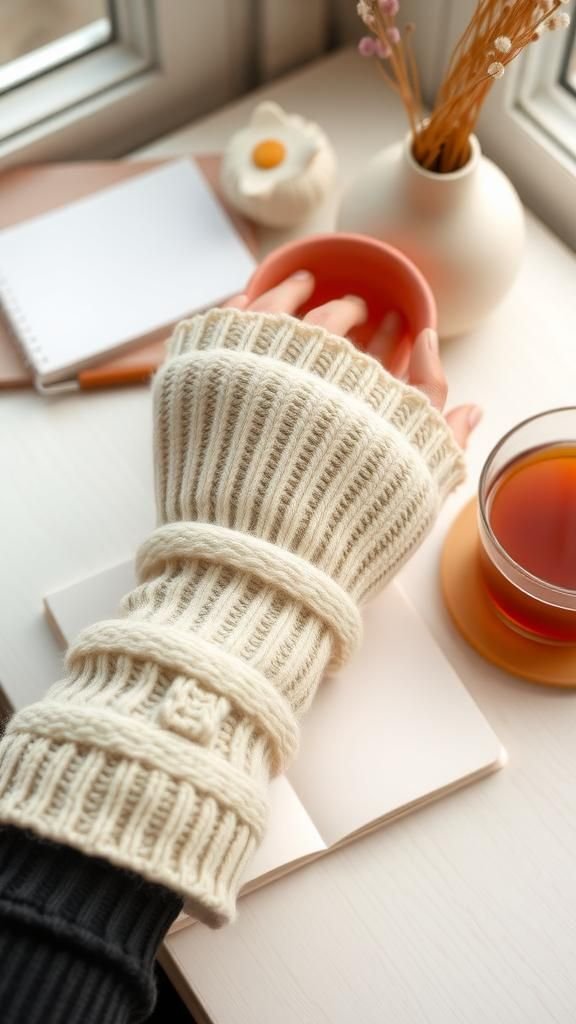
Fingerless ribbed wrist warmers embrace the charm of sweater sleeves repurposed as versatile accessories that blend comfort and freedom. The materials palette typically centers on ribbed sweater cuffs, lightweight lining snippets where needed, and subtle decorative elements like small buttons or embroidery.
Styling fits layered looks, desk-bound chill, and mobile phone use while maintaining a hand-crafted aesthetic. Use cases include office warmth, crafting sessions, and travel where dexterity is useful.
Color and finish options range from soft pastels to rich autumn tones, and gift display ideas include pairing with a matching scarf for a coordinated set.
Steps
- Select a sweater sleeve with a neat ribbed cuff and determine the desired wrist length, marking the cut line across the sleeve.
- Cut the sleeve at the marked line and trim any excess, leaving the ribbed cuff intact for a finished edge.
- Hem the raw top edge of the sleeve by folding and stitching or by sewing a narrow band to prevent stretching.
- Add decorative touches like a small button tab or simple embroidered motif along the wrist area for personality.
- Inspect seams and trim loose threads for a tidy presentation before gifting or wearing.
Cable Knit Patterned Mittens With Heirloom Feel
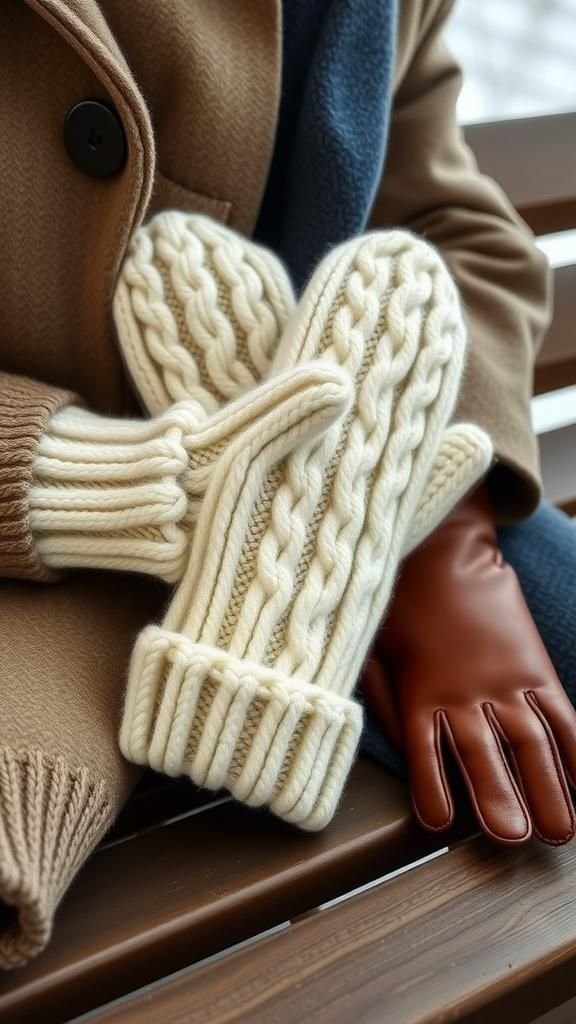
Cable knit patterned mittens celebrate the textured beauty of traditional sweaters transformed into heirloom accessories. The materials palette highlights sculpted cable panels, cozy linings, and subtle reinforcement at stress points for longevity.
Styling leans toward classic outerwear, pairing beautifully with wool coats and knitted scarves for a curated winter look. Use cases include weekend walks, family outings, and gifting to someone who appreciates tactile detail.
Color and finish choices range from natural cream cables to deep forest hues, and display ideas include wrapping in vintage paper with a handwritten note for sentimental value.
Steps
- Identify a sweater section with prominent cable patterns and position a mitten template to capture the cable centerpiece within the palm area.
- Cut two mirrored outer mitten pieces ensuring the cable motif aligns symmetrically across the pair.
- Prepare lining pieces and assemble outer and lining mittens by sewing seam lines along the sides and shaping the thumb gusset.
- Insert the lining into the outer mitten and finish the cuff edge with a secure seam to maintain knit shape.
- Add a small reinforcing stitch at the thumb base to increase durability for repeated wear.
Convertible Flip-Top Mitten For Versatile Warmth

A convertible flip-top mitten blends the convenience of finger freedom with mitten-level warmth, using reclaimed sweater fabric for a tactile, cozy result. The materials palette includes a sweater body, a flip-top panel that rests over the fingers when warmth is desired, and a soft lining to maintain comfort.
Styling favors layered urban outfits and on-the-go warmth for outdoor vendors or commuters. Use cases span hands-on tasks outdoors, casual strolls, and unpredictable weather.
Color and finish options may include coordinating contrast panels, and gifting could be presented in a small cotton drawstring pouch for thoughtful packaging.
Steps
- Cut outer mitten pieces from sweater fabric, including a separate flip-top panel sized to cover fingers when folded over.
- Construct the main mitten by sewing outer pieces and a separate lining, leaving an opening at the cuff for turning.
- Attach the flip-top panel along its base to the mitten outer, allowing it to move freely over the fingers.
- Finish seams and turn the lining right side out through the cuff opening, then close the opening with a neat stitch.
- Add an optional small snap or button loop to hold the flip-top back when not in use for secure wear.
Embroidered Memory Mittens With Sentimental Motifs

Embroidered memory mittens elevate upcycled sweater mittens into keepsakes by incorporating stitched motifs drawn from meaningful moments. The materials palette combines reclaimed knit fabric, embroidery thread in complementary hues, and a delicate lining that preserves comfort.
Styling turns mittens into conversation pieces that accent simple coats or vintage ensembles. Use cases include gifting for anniversaries, memorial tokens, or holiday surprises that carry personal symbols.
Color and finish options often mirror the original sweater tones, while contrast thread adds visual interest. Presentation might pair the mittens with a small card explaining the motif for emotional resonance.
Steps
- Select a sweater panel with a smooth knit surface suitable for embroidery and decide on a motif to represent a memory or sentiment.
- Transfer the motif outline onto the knit using a removable fabric marker, ensuring placement aligns with mitten seams when cut.
- Execute the embroidery with stable stitches and complementary thread colors, reinforcing the design with small backstitches or satin fills.
- Cut the embroidered panel into outer mitten shapes and assemble with a soft lining by sewing seam lines and shaping the thumb.
- Finish the cuff seam neatly and trim excess threads, leaving the embroidered motif centered and well framed on the mitten.
Kids’ Playful Character Mittens With Felt Faces
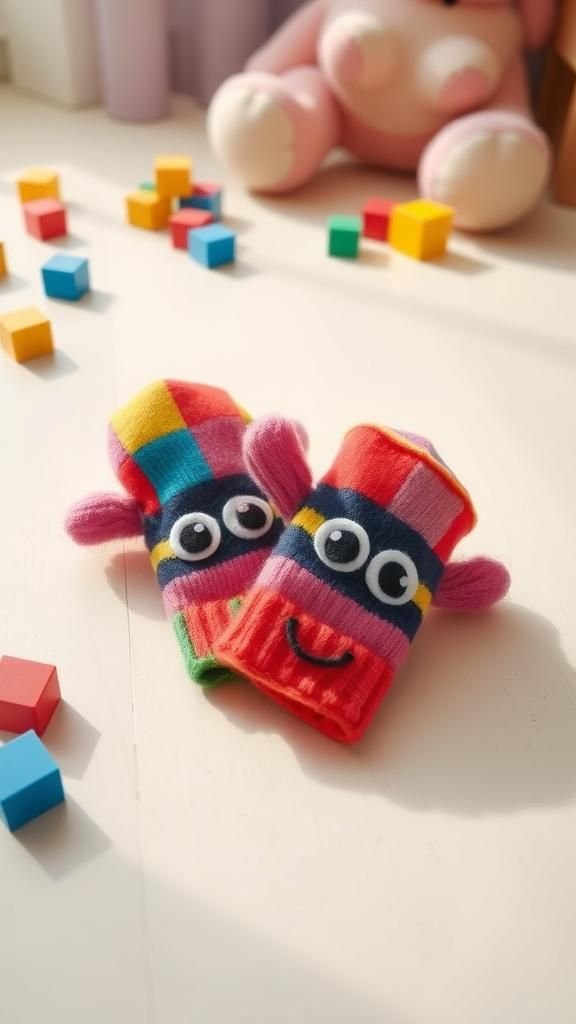
Kids’ playful character mittens transform sweater sleeves into delightful wearable toys that charm young wearers and caretakers alike. The materials palette mixes colorful sweater scraps, felt appliqué for faces, and sturdy lining for active use.
Styling suits cheerful children’s outerwear and bright winter accessories that spark imagination. Use cases include school recess, family outings, and giftable surprises for birthdays or holidays.
Color and finish options range from primary brights to soft pastels, and packaging could feature a small story tag that introduces the mitten character for an added playful touch.
Steps
- Choose a durable sweater with bright colors and trace a child-sized mitten template onto the fabric, keeping proportions suitable for small hands.
- Cut felt pieces for facial features and affix them to the mitten outer using secure stitches, reinforcing attachment points for durability.
- Sew outer mitten pieces together and construct a soft lining to protect the appliqué and increase warmth.
- Insert the lining into the outer mitten, align seams carefully, and stitch the cuff closure to finish the edge.
- Inspect the mitten for secure appliqué attachment and trim any loose threads before gifting to a child.
Textured Patch Pocket Mittens With Handy Storage

Textured mittens featuring a small patch pocket blend tactile interest with miniature practicality, reimagining sweater panels into functional warmth. The materials palette typically includes textured knit remnants for the pocket, a comfortable lining, and discreet reinforcement where the pocket meets the mitten body.
Styling complements casual outerwear and garments where compact storage of tiny items is appreciated. Use cases include holding lip balm, transit cards, or a small hand warmer during outings.
Color and finish choices might contrast pocket and body for visual emphasis, and presentation could include a tiny stitched label noting its repurposed origins.
Steps
- Select a sweater panel with an interesting texture and cut the main mitten shapes along with a small rectangle for the patch pocket.
- Hem the top edge of the pocket piece and position it on the outer mitten panel, securing it with a row of neat stitches along the sides and bottom.
- Assemble the outer mitten pieces by sewing seam lines and shaping the thumb gusset, ensuring pocket placement remains centered.
- Construct the lining and insert it into the outer shell, closing the cuff seam with a tidy stitch.
- Optionally reinforce pocket corners with an extra stitch to increase longevity for regular use.
Nordic Inspired Braided Trim Mittens With Contrast
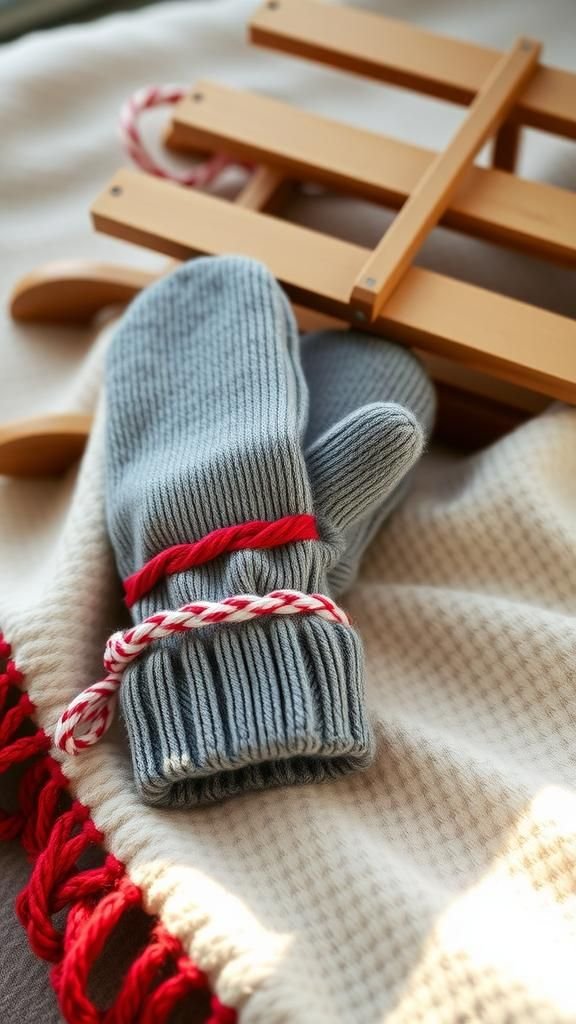
Nordic inspired mittens bring cultural charm to upcycled sweater mittens through braided trims and geometric accents that highlight heritage motifs. The materials palette includes patterned sweater sections, braided yarn trims in complementary colors, and a snug lining that keeps the silhouette clean.
Styling matches layered winter looks and classic outerwear, offering a hint of folk elegance. Use cases embrace weekend travel, holiday markets, and thoughtful gifting for those who appreciate artisan details.
Color and finish options often contrast bright braids against muted bases, and display might feature a small tag explaining the inspiration behind the braiding.
Steps
- Source sweater panels with Nordic patterns or neutral backgrounds suitable for adding a braided trim along the wrist or seam.
- Braid lengths of yarn in contrasting hues and stitch the braid along the chosen seam line, positioning it to enhance the mitten shape.
- Cut outer and lining mitten shapes and assemble each component by sewing side seams and forming the thumb.
- Insert the lining into the outer mitten, align the braid trim, and finish the cuff seam for a polished edge.
- Give the mittens a final inspection for secure trim attachment and tidy up any stray fibers.
Buttoned Foldover Wrist Mittens With Vintage Flair

Buttoned foldover wrist mittens offer a nostalgic silhouette with a foldable cuff secured by vintage buttons, lending old-world charm to upcycled sweater materials. The materials palette pairs reclaimed knit with decorative buttons, a cozy lining, and optional embroidered buttonholes that add character.
Styling works well with tailored coats and vintage-inspired ensembles, creating a curated winter aesthetic. Use cases include afternoon strolls, nostalgic gifting, and special outings where graceful details are appreciated.
Color and finish options run from muted tones with antique brass buttons to playful contrasts with bold, modern buttons, presented in a small fabric pouch.
Steps
- Cut mitten outer pieces from a sweater panel, leaving extra length at the cuff to allow for a foldover flap that will host a decorative button.
- Prepare the lining and sew the main mitten seams while keeping the cuff area open for turning and folding.
- Fold the cuff flap to the desired width and mark button placement, attaching decorative buttons securely along the fold area.
- Close the cuff seam neatly and insert the lining into the outer mitten, ensuring button placement remains aligned when folded.
- Reinforce the button area with small stitches for durability and trim excess threads for a finished appearance.
Fleece Lined Travel Mittens For Cold Commuters
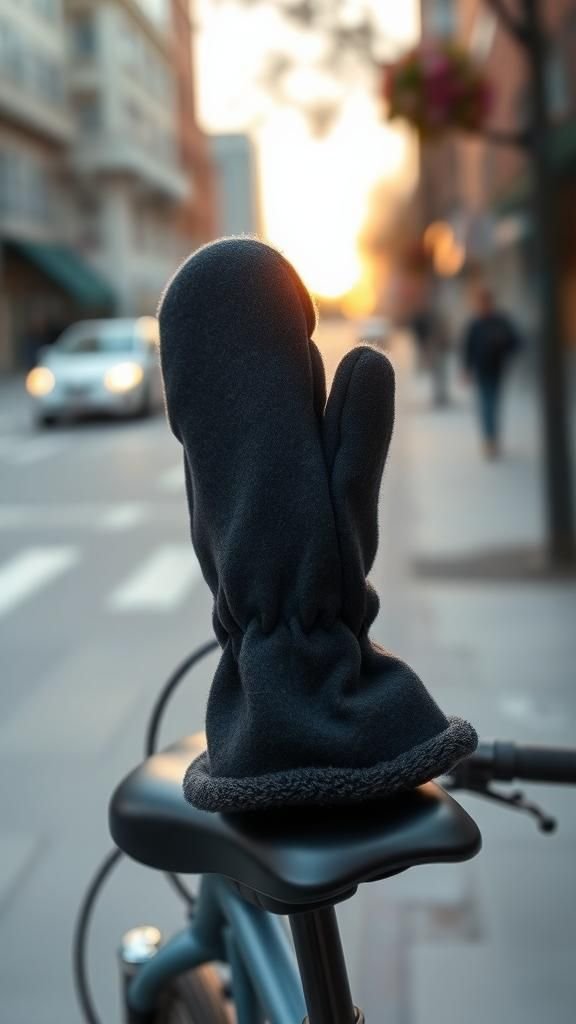
Fleece lined travel mittens balance warmth and practicality by pairing durable sweater exteriors with insulating fleece interiors tailored for busy commuters. The materials palette centers on tightly knit sweater panels, high-loft fleece for lining, and subtle reinforcement at palms for frequent use.
Styling complements commuter coats and practical outerwear, offering compact comfort for daily transit. Use cases include bicycle rides, bus stops, and brisk walks between errands.
Color and finish options include neutral solids that hide wear well or reflective trims for low-light trips. Presentation might include a small label with care notes for the frequent traveler.
Steps
- Choose a dense sweater fabric for the outer layer and cut mitten shapes sized for a snug fit, planning for fleece lining thickness.
- Cut matching lining pieces from a warm fleece, ensuring good coverage of the palm and back of the hand.
- Sew the outer pieces together and assemble the fleece lining separately, leaving an opening to join them at the cuff.
- Insert the lining into the outer shell, align seams carefully, and complete the cuff seam with a strong stitch.
- Add optional palm reinforcement patches from a durable fabric to extend the mitten lifespan for daily commuting.
Thumb Gusset Shaped Mittens For Comfortable Fit

Thumb gusset shaped mittens highlight ergonomic shaping derived from sweater panels, offering a comfortable, articulated fit that moves with the hand. The materials palette emphasizes flexible knit sections for the gusset, a soft lining to prevent rubbing, and gentle reinforcement at high-wear areas.
Styling suits everyday layers and practical outerwear where comfort reigns. Use cases include chores, outdoor hobbies, and occasions demanding dexterity without sacrificing warmth.
Color and finish choices might echo the original sweater tones or introduce a contrasting gusset for visual interest, and presentation could showcase a small note about the recycled material source.
Steps
- Trace a mitten pattern that includes a thumb gusset onto the sweater fabric, ensuring the gusset area follows the natural curve of the hand.
- Cut outer pieces carefully to preserve knit stretch where the thumb will join the body, then cut matching lining pieces.
- Sew the gusset pieces to the palm and back panels, shaping the thumb area with even stitching to allow natural movement.
- Assemble the rest of the mitten by closing side seams and attaching the cuff, then insert the lining and finish the cuff seam.
- Test the fit and reinforce stress points with a small backstitch where needed for durability.
Minimalist Seamless Mittens From Circular Sleeve Cuts
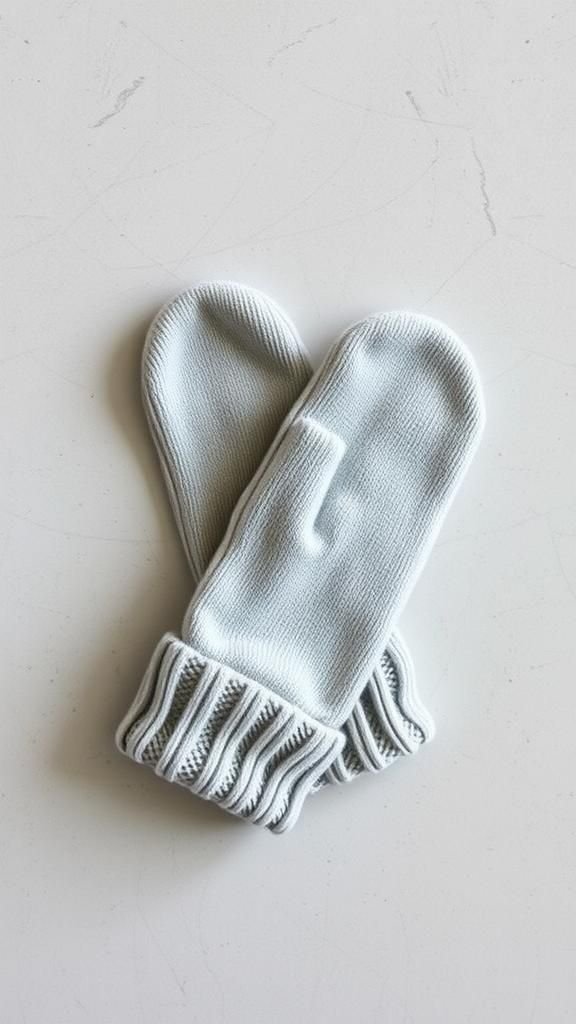
Minimalist seamless mittens emerge from circular sleeve cuts that preserve knit continuity and produce a sleek, modern accessory. The materials palette prioritizes smooth sweater tubes, a thin soft lining if desired, and subtle finishing at the wrist for a clean silhouette.
Styling aligns with contemporary coats and monochrome outfits where understated details speak volumes. Use cases include city errands, gallery visits, and refined gifting.
Color and finish options favor single-tone palettes or gentle marl effects, and display could embrace minimal packaging such as a recycled cardboard band with a simple label describing the upcycled origin.
Steps
- Identify a sweater sleeve with consistent knit and lay it flat, marking a circular section sized to fit the hand plus seam allowance.
- Cut a circular tube section and cut it open along one side to create a mitten-shaped piece with minimal visible seams.
- Shape a thumb opening by cutting and reinforcing the edge with small stitches or a narrow hem for durability.
- Add a lining by inserting a slim tube of soft fabric and securing it at the wrist with neat stitching.
- Finish the cuff edge with a tidy hem and trim stray fibers for a polished minimalist appearance.
Seamed Patch Embellished Mittens With Rustic Look

Seamed patch embellished mittens spotlight reclaimed sweater fragments assembled with visible seams that add rustic handmade appeal. The materials palette blends textured patches, complementary thread, and a cozy lining that softens the interior feel.
Styling complements artisanal coats and layered knits, lending a crafted statement to winter outfits. Use cases include craft fairs, handmade markets, and gifting to admirers of visible handiwork.
Color and finish options often juxtapose rough edges with soft linings for contrast, and presentation might include a fabric swatch attached as a keepsake of the original sweater source.
Steps
- Gather small sweater fragments with interesting textures and arrange them to form a mitten-sized outer panel, aligning edges for visible seaming.
- Stitch the patches together with decorative running stitches that accentuate the handmade aesthetic, forming a unified outer fabric.
- Cut matching lining pieces and assemble both layers by sewing seam lines and shaping the thumb area.
- Insert the lining into the outer assembly and close the cuff seam with a sturdy stitch.
- Add a small fabric label with a handwritten note about the sweater origin for an authentic presentation.
Lace Cuff Vintage Sweater Mittens With Feminine Touch

Lace cuff vintage mittens combine the softness of reclaimed knits with delicate lace accents that introduce a feminine, romantic vibe. The materials palette includes sweater fabric for the mitten body, lace trims rescued from old garments, and a smooth lining that prevents itchiness.
Styling plays well with vintage coats, lace scarves, and tea dress ensembles, offering a gentle contrast between cozy knit and delicate trim. Use cases include garden gatherings, festive events, and heartfelt gifting.
Color and finish options range from soft ivory and blush to warm taupe, with presentation in tissue-lined boxes for an elegant reveal.
Steps
- Select sweater fabric for the mitten body and a complementary length of lace trim sized to encircle the cuff.
- Cut the outer mitten pieces and matching lining shapes, positioning the lace trim to sit gracefully over the cuff area.
- Affix the lace trim to the outer mitten by sewing along the seam allowance, ensuring the lace lays flat and decorative.
- Assemble the mitten by sewing outer pieces, constructing the lining, inserting it into the shell, and finishing the cuff seam.
- Inspect the lace attachment for secure stitching and trim any loose threads for refinement.
Reversible Two-Tone Mittens For Style Flexibility
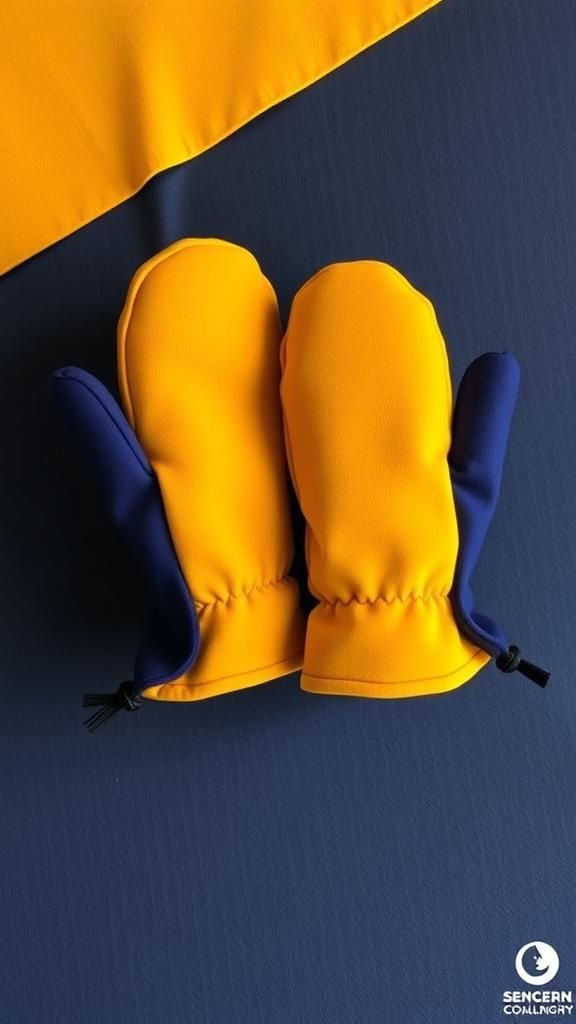
Reversible two-tone mittens maximize wardrobe options by offering opposite faces that reverse for new color combinations and fresh looks. The materials palette brings together two sweaters or a two-sided knit, a soft central seam for stability, and a plush lining to enhance comfort.
Styling allows quick outfit changes and playful coordination with coats and hats. Use cases include travel where packing space is at a premium and gifting that celebrates multifunctional design.
Color and finish options range from bold contrasts to subtle tonal shifts, and presentation might show both sides folded for an intriguing unboxing experience.
Steps
- Cut two mitten shells from contrasting sweater fabrics, making pairs that will form the reversible faces of the mitten.
- Sew each shell together separately, leaving cuff openings to join the two shells later for a clean reversible seam.
- Insert one shell into the other with right sides facing out and align the cuff edges for a symmetrical finish.
- Stitch the cuffs together around the opening to secure both layers, then turn the mitten to reveal the finished reversible faces.
- Smooth seam lines and trim loose fibers for a polished look before gifting or wearing.
Memory Pocket Mittens For Tiny Keepsake Holding
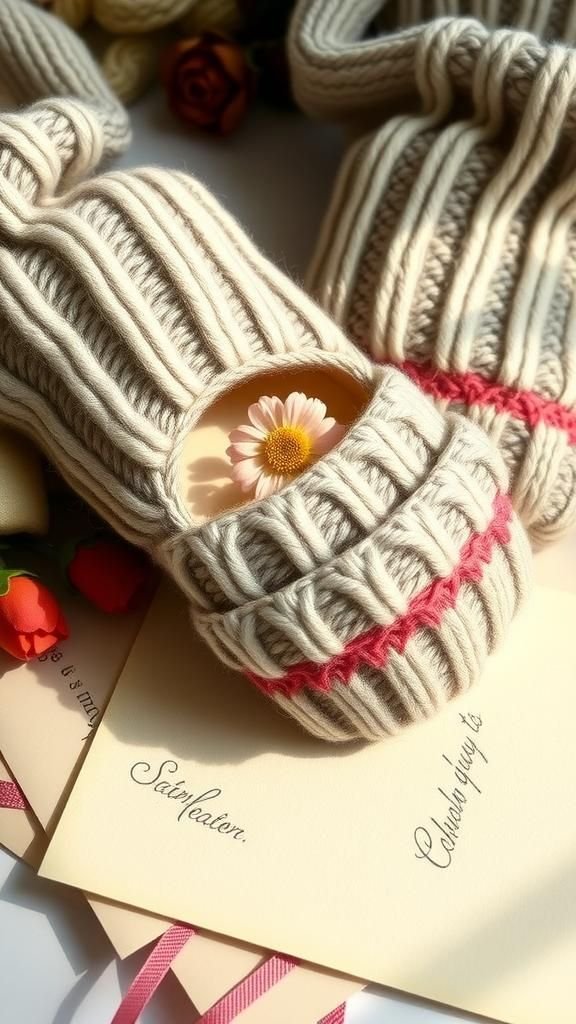
Memory pocket mittens introduce a secret interior pocket designed to protect a tiny keepsake, blending tender sentiment with recycled knit warmth. The materials palette includes a sweater exterior, a small internal pocket of soft fabric, and a plush lining that keeps the treasure cushioned.
Styling places these mittens among thoughtful accessories for intimate gifting occasions or memorial gestures. Use cases include safekeeping of a small charm, a pressed flower, or a sentimental note while out and about.
Color and finish choices aim for calming tones, and presentation could include a small card describing the pocket’s purpose.
Steps
- Cut outer mitten pieces from a sweater panel and prepare a small rectangular pocket piece from soft fabric sized to hold a tiny keepsake.
- Hem the top edge of the pocket and position it inside the lining piece, sewing three sides to create a secure pouch.
- Assemble the outer mitten by stitching side seams and shaping the thumb, constructing the lined mitten with the pocket integrated into the lining.
- Insert the lining into the outer shell and complete the cuff seam with a neat stitch.
- Test the pocket opening for secure closure and add a small stitch if reinforcement is needed for safe carriage.
Contrast Thumb Mittens With Playful Pop Of Color

Contrast thumb mittens bring a playful visual accent by highlighting the thumb with a different color or texture, breathing new life into reclaimed sweaters. The materials palette combines the main sweater body with a contrasting thumb patch crafted from a leftover sleeve or bright knit scrap, plus a cozy lining for comfort.
Styling adds a quirky touch to everyday coats and casual knit ensembles. Use cases include making a subtle statement on walks or gifting someone who loves small, joyful details.
Color and finish options range from neon pops to gentle pastels, with presentation wrapped in bright tissue.
Steps
- Cut main mitten outer shapes from the sweater fabric and cut a small contrasting piece for the thumb from a different sweater scrap.
- Attach the contrasting thumb piece to the thumb opening of the outer mitten by sewing along the seam line for a snug join.
- Construct the lining separately and assemble the main mitten body by sewing side seams and shaping the thumb base.
- Insert the lining into the outer shell and finish the cuff seam with even stitching to secure both layers.
- Add a light topstitch around the thumb seam to emphasize the contrast and tidy the finish.
Smocked Wrist Mittens With Gathered Decorative Detail

Smocked wrist mittens introduce gathered detailing at the wrist that mimics couture touches and elevates upcycled sweater aesthetics. The materials palette unites sweater fabric with a gathered trim or smocked band and a comfortable lining that maintains wearability.
Styling suits dresses and fitted coats for a refined juxtaposition of cozy and tailored. Use cases include holiday gatherings, special outings, and gifting for someone who appreciates refined craftsmanship.
Color and finish options might pair soft tones with tonal gathering or contrast for emphasis, and presentation could include a small card describing the handmade technique used.
Steps
- Cut mitten outer pieces from the sweater fabric and prepare a narrow smocked band from a stretchable knit or a gathered fabric strip.
- Secure the smocked band to the wrist area of the outer mitten by stitching around the seam allowance, ensuring gathers distribute evenly.
- Construct the lining pieces and assemble the mitten body by sewing side seams and forming the thumb gusset.
- Insert the lining into the outer mitten and finish the cuff seam to enclose the smocked band neatly.
- Smooth gathers and trim any excess threads for a clean, elegant finish before gifting.
Miniature Wristlet Mittens Doubles As Keyring Charm
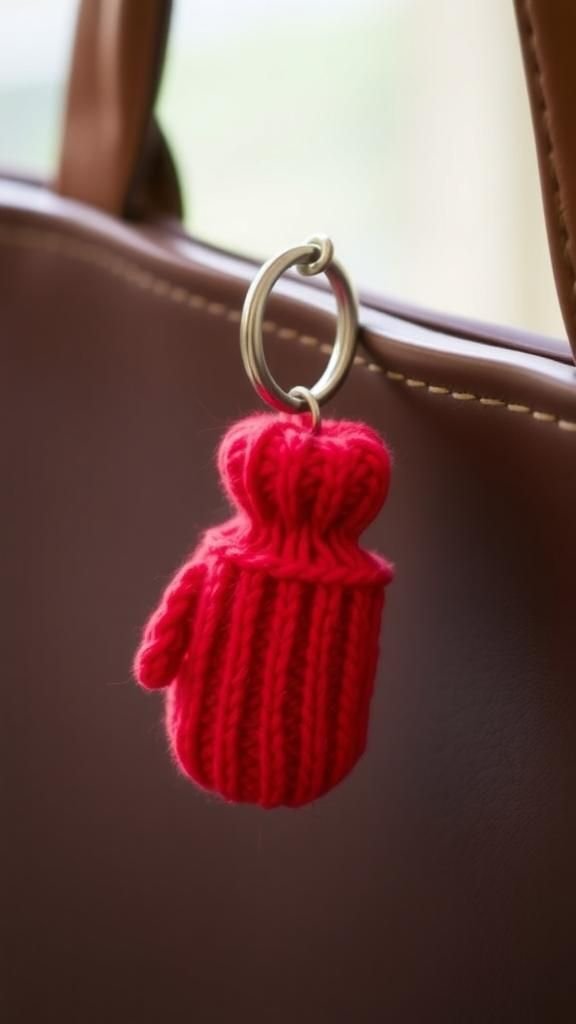
Miniature wristlet mittens reimagine upcycled sweater scraps as tiny charms that double as decorative keyrings or bag ornaments. The materials palette focuses on small knit remnants, lightweight stuffing for shape, and a secure loop or ring for attachment.
Styling suits personalization of bags, purses, or keys and adds a handcrafted accent to everyday items. Use cases include gift tags, stocking stuffers, and keepsakes reflecting a favorite sweater.
Color and finish options often mirror bold hues for visibility, and presentation could include attaching the miniature mitten to a gift tag as a memorable embellishment.
Steps
- Cut two tiny mitten shapes from a sweater scrap, small enough to serve as a charm, and prepare a thin lining if needed for stability.
- Sew the outer pieces together along the sides, leaving a small opening for light stuffing that shapes the charm.
- Lightly stuff the miniature mitten with polyester fill or fabric scraps and close the opening with a neat stitch.
- Attach a small loop or metal keyring securely at the cuff area with reinforced stitching.
- Trim stray fibers and inspect the ring attachment for sturdiness before gifting or attaching to a bag.